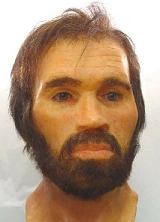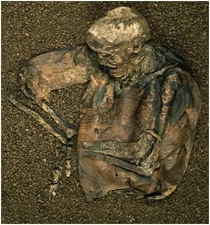Lindow Man was found in a peat bog in the summer of 1984. The body and surrounding section of peat were removed whole and taken away for study by a team led by British Museum scientists. Only the top half of the individual was recovered, everything from the stomach down was not recovered.
Mummification[]
Lindow was preserved by the conditions of the bog, a cold, acidic environment lacking in oxygen. These are places hostile to microorganisms that cause bodies to decompose, and sphagnum mosses, which grow in bogs, release a substance that functions as a tanning agent. Therefore, skin, tendons, ligaments, and muscles, are turned into leather.
Studies[]
The mummy was found by Andy Mould on August 1, 1984 and his body was transported to the British Museum for study. Possessed of a beard, sideburns, and mustache showed that the body was male. It was estimated that he would have been between 1.68 m and 1.73 m (5 foot 6 - 5 foot 8 inches) tall. He was well built, weighing around 64 kg (140 lbs). The remains was radiocarbon dated to the 1st Century AD. He was about 25 years old at the time of death.
The body was unclothed, apart from a fox fur armband. Researchers found that his hair and beard had been trimmed with a pair of scissors or shears prior to his death. It is believed he did not do any hard labor, based on his nails which were all well manicured. Nor were there visible cavities in his teeth though some were well worn. Overall he appears to have been healthy, although he had slight osteoarthritis and an infestation of parasitic worms.

Life-sized facial reconstruction in wax, of Lindow Man by R.A.H. Neave
His blood group was discovered to have been O.
Food residue discovered in his upper alimentary tract shows that his last meal was a griddle cake made from wheat and barley.
He had a thin cord around his neck which may have been used to strangle him and break his neck, but some have argued that it was simply a necklace, because it is knotted in a decorative manner.
The prevailing theory is that he was a sacrifice, but by whom and for what reason is unknown.
In 1984 a right foot was found by Mould. In June and September 1988, parts of the Lindow Man's buttock and the left leg were found close to the spot where his body had been initially excavated.
Pathology[]
The mummy was discovered to have been struck twice at the top of his head, and once at the base of his skull. The blows were theorized to be from a narrow bladed axe. Xeroradiography revealed his skull was fractured and fragments were driven into the brain. Swelling around the edges of the wound suggest that Lindow Man did not die immediately after sustaining this injury but may have survived for several hours afterwards. He also received a blow to his back, which broke one of his ribs, a possible wound on the right side of his neck, a possible stab wound in the upper right chest, and a broken neck. After death, his throat was cut and he was placed face down in a pool in the bog. The sequence of events suggest that he may have been apart of a ritual killing.
Several grains of mistletoe pollen were also found in his intestines although it is unclear if it was accidentally or deliberately ingested, but suggest that Lindow Man died in late winter or early spring.
Additional[]
The mummy is housed in the British Museum, located in a case at the top of the staircase from the ground floor.
References[]
Deem, J.M. (n.d.). Lindow Man. Retrieved June 13, 2015, from http://www.mummytombs.com/mummylocator/featured/lindowman.htm.
The British Museum. (n.d.).Lindow Man. Retrieved June 13, 2015, from http://www.britishmuseum.org/explore/highlights/highlight_objects/pe_prb/l/lindow_man.aspx.
